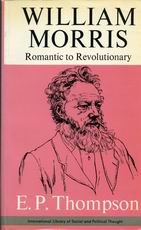
William Morris
From Romantic to Revolutionary
Thompson, E. P.
Publisher: Pantheon
Year First Published: 1955
Year Published: 1977
Pages: 825pp Resource Type: Book
Cx Number: CX8119
A biography of the nineteenth-century socialist, designer, artist, and intellectual William Morris.
Abstract:
Born into a privileged family, William Morris grew to become a poet, writer and painter. As this biography shows, the British Socialist led a strenuous, imaginative and intellectual life.
Morris was a designer and artist who hated capitalism. He disapproved of the 'squalour and anarchy' that existed throughout London and wished to rid the city of its 'degraded architecture' by becoming a painter and designer. He felt England faced the 'immovable façade of Victorian society' in its architectural development. Ruskin's writings were perhaps of greatest importance in leading Morris toward his choice of art as the central battleground.
The Mannerists, who were heavily influenced by Raphael and the Renaissance, led the 19th century art world. Morris was a part of a movement against the Mannerists: the Pre-Raphaelite Brotherhood, which Morris regarded as 'an audacious attempt and revolt against the Academical Art,' which was taught in the schools of Europe.
For Morris, the most important result of the new scholarship that came out of the ashes of the Middle Ages was in the reconstruction of an idea of a real community of human beings whose seeds lay in pre-capitalist notions of community.
Morris and his allies shared a hatred of Victorianism, had a persistent underlying element of respect for the personality of women, and a yearning for a fully equal relationship of love and companionship between the sexes.
This biography also deals extensively with Morris' involvement in the socialist movement and the revolutionary and artistic struggles of his time.
[Abstract by Vei Chong]
Table of Contents
Foreword
List of Abbreviations
Part I: William Morris and the Romantic Revolt
1. Sir Launcelot and Mr Gradgrind
2. Oxford - Carlyle and Ruskin
3. Rosetti and the Pre-Raphaelites
4. The First Joust with Victorianism
Part II: The Years of Conflict
5. William Morris and the Decorative Arts
6. The Poetry of Despair
7. "Love is Enough"
8. Hope and Courage
9. Action
10. The 'Anti-Scrape'
11. The River of Fire
Part III: Practical Socialism
12. The First 200
13. The First Propaganda
14. The Split
15. The Socialist League 1885-6: "Making Socialists"
16. The Socialists made contact with the masses, 1887-8
17. The Last Years of the Socialist League
18. Towards a United Socialist Party, 1890-96
Part IV: Necessity and Desire
19. Necessity and Desire
Appendices
The Manifesto of the Socialist League
William Morris, Bruce Glasier and Marxism
Postscript: 1976
Index
Subject Headings


